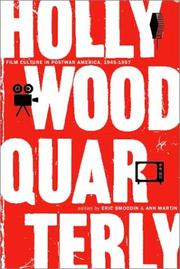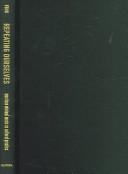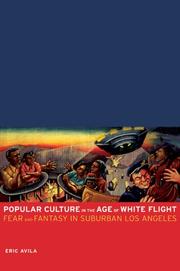| Listing 1 - 10 of 13 | << page >> |
Sort by
|

ISBN: 9780807858738 Year: 2008 Publisher: Chapel Hill the University of North Carolina Press
Abstract | Keywords | Export | Availability | Bookmark
 Loading...
Loading...Choose an application
- Reference Manager
- EndNote
- RefWorks (Direct export to RefWorks)
Bill Bright --- Campus Crusade for Christ --- Evangelicalism in postwar America --- World War II --- American history --- religious pluralism --- media culture --- post-1945 conservatism --- 1951

ISBN: 0520232739 0520232747 0520936329 9786612762604 159734656X 1282762605 9780520936324 1417525444 9781417525447 9781597346566 9780520232730 9780520232747 9781282762602 6612762608 Year: 2002 Publisher: Berkeley, California University of California Press
Abstract | Keywords | Export | Availability | Bookmark
 Loading...
Loading...Choose an application
- Reference Manager
- EndNote
- RefWorks (Direct export to RefWorks)
The first issue of Hollywood Quarterly, in October 1945, marked the appearance of the most significant, successful, and regularly published journal of its kind in the United States. For its entire life, the Quarterly held to the leftist utopianism of its founders, several of whom would later be blacklisted. The journal attracted a collection of writers unmatched in North American film studies for the heterogeneity of their intellectual and practical concerns: from film, radio, and television industry workers to academics; from Sam Goldwyn, Edith Head, and Chuck Jones to Theodor Adorno and Siegfried Kracauer. For this volume, Eric Smoodin and Ann Martin have selected essays that reflect the astonishing eclecticism of the journal, with sections on animation, the avant-garde, and documentary to go along with a representative sampling of articles about feature-length narrative films. They have also included articles on radio and television, reflecting the contents of just about every issue of the journal and exemplifying the extraordinary moment in film and media studies that Hollywood Quarterly captured and helped to create. In 1951, Hollywood Quarterly was renamed the Quarterly of Film, Radio, and Television, and in 1958 it was replaced by Film Quarterly, which is still published by the University of California Press. During those first twelve years, the Quarterly maintained an intelligent, sophisticated, and critical interest in all the major entertainment media, not just film, and in issue after issue insisted on the importance of both aesthetic and sociological methodologies for studying popular culture, and on the political significance of the mass media.
Motion pictures --- Cinéma --- History --- Social aspects --- Histoire --- Aspect social --- Culture in motion pictures. --- History. --- 20th century. --- academics. --- anthology. --- avant garde film. --- discussion books. --- documentary. --- entertainment. --- essay collection. --- film culture. --- film historians. --- film journalism. --- film scholars. --- film students. --- film studies. --- historical. --- hollywood. --- intellectual perspective. --- journal archives. --- leftist utopianism. --- mass media. --- media studies. --- narrative films. --- nonfiction. --- pop culture. --- postwar america. --- retrospective. --- sociological. --- textbooks. --- united states.
Book
ISBN: 1501709534 9781501709531 9781501712173 1501712179 9780801450488 0801450489 Year: 2018 Publisher: Ithaca, NY
Abstract | Keywords | Export | Availability | Bookmark
 Loading...
Loading...Choose an application
- Reference Manager
- EndNote
- RefWorks (Direct export to RefWorks)
In the critically acclaimed La Fin de la Pauverté, Romain D. Huret identifies a network of experts who were dedicated to the post-World War II battle against poverty in the United States. John Angell's translation of Huret's work brings to light for an English-speaking audience this critical set of intellectuals working in federal government, academic institutions, and think tanks. Their efforts to create a policy bureaucracy to support federal socio-economic action spanned from the last days of the New Deal to the late 1960s when President Richard M. Nixon implemented the Family Assistance Plan. Often toiling in obscurity, this cadre of experts waged their own war not only on poverty but on the American political establishment. Their policy recommendations, as Huret clearly shows, often militated against the unscientific prejudices and electoral calculations that ruled Washington D.C. politics.The Experts' War on Poverty highlights the metrics, research, and economic and social facts these social scientists employed in their work, and thereby reveals the unstable institutional foundation of successive executive efforts to grapple with gross social and economic disparities in the United States. Huret argues that this internal war, coming at a time of great disruption due to the Cold War, undermined and fractured the institutional system officially directed at ending poverty. The official War on Poverty, which arguably reached its peak under President Lyndon B. Johnson, was thus fomented and maintained by a group of experts determined to fight poverty in radical ways that outstripped both the operational capacity of the federal government and the political will of a succession of presidents.
Economic assistance, Domestic --- Poor --- Poverty --- Destitution --- Wealth --- Basic needs --- Begging --- Subsistence economy --- Disadvantaged, Economically --- Economically disadvantaged --- Impoverished people --- Low-income people --- Pauperism --- Poor, The --- Poor people --- Persons --- Social classes --- Anti-poverty programs --- Government economic assistance --- Economic policy --- National service --- Grants-in-aid --- History --- Economic conditions --- E-books --- poverty in postwar america, Welfare state, war on poverty, Lyndon B. Johnson, poverty.
Book
ISBN: 022641941X Year: 2015 Publisher: Chicago : University of Chicago Press,
Abstract | Keywords | Export | Availability | Bookmark
 Loading...
Loading...Choose an application
- Reference Manager
- EndNote
- RefWorks (Direct export to RefWorks)
Americans believe strongly in the socially transformative power of education, and the idea that we can challenge racial injustice by reducing white prejudice has long been a core component of this faith. How did we get here? In this first-rate intellectual history, Leah N. Gordon jumps into this and other big questions about race, power, and social justice. To answer these questions, From Power to Prejudice examines American academia-both black and white-in the 1940s and '50s. Gordon presents four competing visions of "the race problem" and documents how an individualistic paradigm, which presented white attitudes as the source of racial injustice, gained traction. A number of factors, Gordon shows, explain racial individualism's postwar influence: individuals were easier to measure than social forces; psychology was well funded; studying political economy was difficult amid McCarthyism; and individualism was useful in legal attacks on segregation. Highlighting vigorous midcentury debate over the meanings of racial justice and equality, From Power to Prejudice reveals how one particular vision of social justice won out among many contenders.
Race discrimination --- Prejudices --- History --- United States --- Race relations --- african american studies, education policy, cultural anthropology, discrimination, racism, race relations, racial issues, united states, 20th century, injustice, white prejudice, intellectual history, social justice, academia, individualism, postwar america, psychology, mccarthyism, segregation, society, teachers, students, public schools, college, power dynamics.

ISBN: 1282358170 0520938941 1423727584 9786612358173 1598757857 9780520938946 9781423727583 9780520240360 0520240367 9780520245501 0520245504 9781598757859 9781282358171 6612358173 Year: 2005 Publisher: Berkeley University of California Press
Abstract | Keywords | Export | Availability | Bookmark
 Loading...
Loading...Choose an application
- Reference Manager
- EndNote
- RefWorks (Direct export to RefWorks)
Where did musical minimalism come from-and what does it mean? In this significant revisionist account of minimalist music, Robert Fink connects repetitive music to the postwar evolution of an American mass consumer society. Abandoning the ingrained formalism of minimalist aesthetics, Repeating Ourselves considers the cultural significance of American repetitive music exemplified by composers such as Terry Riley, Steve Reich, and Philip Glass. Fink juxtaposes repetitive minimal music with 1970's disco; assesses it in relation to the selling structure of mass-media advertising campaigns; traces it back to the innovations in hi-fi technology that turned baroque concertos into ambient "easy listening"; and appraises its meditative kinship to the spiritual path of musical mastery offered by Japan's Suzuki Method of Talent Education.
Music --- Minimal music --- Music and society --- Meditative music --- Minimalism (Music) --- Minimalist music --- Music, Minimal --- Repetitive music --- Systematic music --- Social aspects. --- History and criticism. --- advertising campaigns. --- america. --- american music. --- consumer society. --- cultural practices. --- disco. --- easy listening. --- hi fi technology. --- mass consumerism. --- mass media. --- minimal music. --- minimalism. --- minimalist aesthetics. --- music and culture. --- music historians. --- music studies. --- musical minimalism. --- musicians. --- musicology. --- nonfiction. --- philip glass. --- popular music studies. --- postwar america. --- repetitive music. --- revisionist account. --- steve reich. --- terry riley. --- united states. --- History and criticism --- Social aspects
Book
ISBN: 9780520959149 0520959140 9781322071367 1322071365 0520277376 9780520277373 9780520277373 9780520283459 0520283457 9780520283459 Year: 2014 Publisher: Berkeley
Abstract | Keywords | Export | Availability | Bookmark
 Loading...
Loading...Choose an application
- Reference Manager
- EndNote
- RefWorks (Direct export to RefWorks)
Food consumption is a significant and complex social activity-and what a society chooses to feed its children reveals much about its tastes and ideas regarding health. In this groundbreaking historical work, Amy Bentley explores how the invention of commercial baby food shaped American notions of infancy and influenced the evolution of parental and pediatric care. Until the late nineteenth century, infants were almost exclusively fed breast milk. But over the course of a few short decades, Americans began feeding their babies formula and solid foods, frequently as early as a few weeks after birth. By the 1950's, commercial baby food had become emblematic of all things modern in postwar America. Little jars of baby food were thought to resolve a multitude of problems in the domestic sphere: they reduced parental anxieties about nutrition and health; they made caretakers feel empowered; and they offered women entering the workforce an irresistible convenience. But these baby food products laden with sugar, salt, and starch also became a gateway to the industrialized diet that blossomed during this period. Today, baby food continues to be shaped by medical, commercial, and parenting trends. Baby food producers now contend with health and nutrition problems as well as the rise of alternative food movements. All of this matters because, as the author suggests, it's during infancy that American palates become acclimated to tastes and textures, including those of highly processed, minimally nutritious, and calorie-dense industrial food products.
Infants --- Babies --- Infancy --- Children --- Nutrition --- History. --- alternative food movements. --- american diet. --- american food. --- babies. --- baby food. --- breast milk. --- california studies in food and culture series. --- commercial baby food. --- commercial foods. --- domestic space. --- family. --- food consumption. --- food. --- formula. --- gastronomy. --- health. --- highly processed foods. --- history. --- industrial food products. --- industrialized diet. --- infancy. --- mothering. --- nutrition and health. --- parental care. --- parenthood. --- parenting trends. --- pediatric care. --- postwar america. --- social activity. --- social norms. --- solid foods. --- united states of america.
Book
ISBN: 0520956680 9781299718197 1299718191 9780520956681 0520274644 9780520274648 0520274652 9780520274655 9780520274648 9780520274655 Year: 2013 Publisher: Berkeley University of California Press
Abstract | Keywords | Export | Availability | Bookmark
 Loading...
Loading...Choose an application
- Reference Manager
- EndNote
- RefWorks (Direct export to RefWorks)
The capital of the U.S. Empire after World War II was not a city. It was an American suburb. In this innovative and timely history, Andrew Friedman chronicles how the CIA and other national security institutions created a U.S. imperial home front in the suburbs of Northern Virginia. In this covert capital, the suburban landscape provided a cover for the workings of U.S. imperial power, which shaped domestic suburban life. The Pentagon and the CIA built two of the largest office buildings in the country there during and after the war that anchored a new imperial culture and social world. As the U.S. expanded its power abroad by developing roads, embassies, and villages, its subjects also arrived in the covert capital as real estate agents, homeowners, builders, and landscapers who constructed spaces and living monuments that both nurtured and critiqued postwar U.S. foreign policy. Tracing the relationships among American agents and the migrants from Vietnam, El Salvador, Iran, and elsewhere who settled in the southwestern suburbs of D.C., Friedman tells the story of a place that recasts ideas about U.S. immigration, citizenship, nationalism, global interconnection, and ethical responsibility from the post-WW2 period to the present. Opening a new window onto the intertwined history of the American suburbs and U.S. foreign policy, Covert Capital will also give readers a broad interdisciplinary and often surprising understanding of how U.S. domestic and global histories intersect in many contexts and at many scales.American Crossroads, 37
Virginia, Northern -- Buildings, structures, etc. --- Intelligence service --- Federal areas within states --- Federal enclaves --- Federal government --- History --- Law and legislation --- Virginia, Northern --- United States --- Northern Virginia --- Foreign relations --- Emigration and immigration --- Government policy. --- american history. --- american suburbs. --- capitalism. --- central intelligence agency. --- cia. --- citizenship. --- close knit communities. --- cold war. --- democracy. --- diplomacy. --- engaging. --- foreign policy. --- global interconnection. --- history. --- imperial power. --- international relations. --- nationalism. --- neighbors. --- northern virginia. --- page turner. --- political geography. --- politics. --- postwar america. --- relationships. --- retrospective. --- suburban landscape. --- the pentagon. --- united states history. --- us foreign policy. --- us immigration. --- virginia. --- washington dc.

ISBN: 1282358472 9786612358470 0520939719 159734821X 9780520939714 9781597348218 1417544961 9781417544967 9780520248113 0520248112 6612358475 0520241215 9780520241213 Year: 2004 Publisher: Berkeley University of California Press
Abstract | Keywords | Export | Availability | Bookmark
 Loading...
Loading...Choose an application
- Reference Manager
- EndNote
- RefWorks (Direct export to RefWorks)
Los Angeles pulsed with economic vitality and demographic growth in the decades following World War II. This vividly detailed cultural history of L.A. from 1940 to 1970 traces the rise of a new suburban consciousness adopted by a generation of migrants who abandoned older American cities for Southern California's booming urban region. Eric Avila explores expressions of this new "white identity" in popular culture with provocative discussions of Hollywood and film noir, Dodger Stadium, Disneyland, and L.A.'s renowned freeways. These institutions not only mirrored this new culture of suburban whiteness and helped shape it, but also, as Avila argues, reveal the profound relationship between the increasingly fragmented urban landscape of Los Angeles and the rise of a new political outlook that rejected the tenets of New Deal liberalism and anticipated the emergence of the New Right. Avila examines disparate manifestations of popular culture in architecture, art, music, and more to illustrate the unfolding urban dynamics of postwar Los Angeles. He also synthesizes important currents of new research in urban history, cultural studies, and critical race theory, weaving a textured narrative about the interplay of space, cultural representation, and identity amid the westward shift of capital and culture in postwar America.
Popular culture --- Public spaces --- White people --- Suburban life --- Suburban life in popular culture --- Migration, Internal --- African Americans --- City and town life --- History --- Race identity --- Social conditions --- Los Angeles (Calif.) --- Civilization --- Race relations. --- 20th century. --- art and architecture. --- california history. --- california. --- conservative right. --- cultural history. --- cultural representation. --- demographic studies. --- disneyland. --- film noir. --- hollywood. --- liberalism. --- los angeles. --- modern history. --- new deal. --- new right. --- nonfiction. --- popular culture. --- postwar america. --- regional history. --- southern california. --- suburban culture. --- suburban landscape. --- suburbs. --- united states. --- urban landscape. --- us history. --- white flight. --- white identity. --- world war ii. --- wwii. --- Whites
Book
ISBN: 0520273753 0520953428 1283860309 9780520953420 9780520273757 9781283860307 Year: 2013 Publisher: Berkeley
Abstract | Keywords | Export | Availability | Bookmark
 Loading...
Loading...Choose an application
- Reference Manager
- EndNote
- RefWorks (Direct export to RefWorks)
Building Home is an innovative biography that weaves together three engrossing stories. It is one part corporate and industrial history, using the evolution of mortgage finance as a way to understand larger dynamics in the nation's political economy. It is another part urban history, since the extraordinary success of the savings and loan business in Los Angeles reflects much of the cultural and economic history of Southern California. Finally, it is a personal story, a biography of one of the nation's most successful entrepreneurs of the managed economy -Howard Fieldstad Ahmanson. Eric John Abrahamson deftly connects these three strands as he chronicles Ahmanson's rise against the background of the postwar housing boom and the growth of L.A. during the same period. As a sun-tanned yachtsman and a cigar-smoking financier, the Omaha-born Ahmanson was both unique and representative of many of the business leaders of his era. He did not control a vast infrastructure like a railroad or an electrical utility. Nor did he build his wealth by pulling the financial levers that made possible these great corporate endeavors. Instead, he made a fortune by enabling the middle-class American dream. With his great wealth, he contributed substantially to the expansion of the cultural institutions in L.A. As we struggle to understand the current mortgage-led financial crisis, Ahmanson's life offers powerful insights into an era when the widespread hope of homeownership was just beginning to take shape.
Mortgage loans --- Savings and loan associations --- American Dream --- Idealism, American --- Materialism --- Success --- Building and loan associations --- Building societies --- Cooperative building associations --- Depository institutions --- Loan associations --- Provident loan associations --- S and L's --- Thrift institutions --- Home loans --- Mortgage lending --- Real estate loans --- Loans --- Secondary mortgage market --- History --- Ahmanson, Howard F. --- E-books --- 20th century america. --- biographical. --- book club books. --- books for history lovers. --- building your own company. --- california history. --- chronicles ahmanson. --- discussion books. --- entrepreneurship. --- history of the american dream. --- history of western united states. --- history. --- how to manage a business. --- how to start a business. --- howard ahmanson. --- industrial history. --- leisure reads. --- managed economy. --- political economy. --- risk management. --- southern california. --- success in postwar america. --- successful entrepreneurs. --- urban history. --- vacation books.
Book
ISBN: 128273251X 9786612732515 0520947398 9780520947399 0520266889 9780520266889 0520266897 9780520266896 Year: 2010 Publisher: Berkeley University of California Press
Abstract | Keywords | Export | Availability | Bookmark
 Loading...
Loading...Choose an application
- Reference Manager
- EndNote
- RefWorks (Direct export to RefWorks)
What, where, and when is jazz? To most of us jazz means small combos, made up mostly of men, performing improvisationally in urban club venues. But jazz has been through many changes in the decades since World War II, emerging in unexpected places and incorporating a wide range of new styles. In this engrossing new book, David Ake expands on the discussion he began in Jazz Cultures, lending his engaging, thoughtful, and stimulating perspective to post-1940's jazz. Ake investigates such issues as improvisational analysis, pedagogy, American exceptionalism, and sense of place in jazz. He uses provocative case studies to illustrate how some of the values ascribed to the postwar jazz culture are reflected in and fundamentally shaped by aspects of sound, location, and time.
Jazz --- Accordion and piano music (Jazz) --- Clarinet and piano music (Jazz) --- Cornet and piano music (Jazz) --- Double bass and piano music (Jazz) --- Jazz duets --- Jazz ensembles --- Jazz music --- Jazz nonets --- Jazz octets --- Jazz quartets --- Jazz quintets --- Jazz septets --- Jazz sextets --- Jazz trios --- Jive (Music) --- Saxophone and piano music (Jazz) --- Vibraphone and piano music (Jazz) --- Wind instrument and piano music (Jazz) --- Xylophone and piano music (Jazz) --- African Americans --- Music --- Third stream (Music) --- Washboard band music --- Social aspects. --- History and criticism. --- History and criticism --- Social aspects --- Coltrane, John --- Davis, Miles Dewey --- Jarrett, Keith --- Metheny, Pat[rick] --- Sex Mob (Jazz band) --- 20th century. --- american exceptionalism. --- artists. --- bebop. --- historical. --- improvisational music. --- jazz age. --- jazz culture. --- jazz historians. --- jazz music. --- jazz musicians. --- jazz scholars. --- jazz scholarship. --- jazz studies. --- jazz styles. --- jazz. --- music and culture. --- music historians. --- music history. --- music movements. --- music pedagogy. --- music venues. --- music. --- musicians. --- musicology. --- nonfiction. --- postwar america. --- retrospective. --- united states. --- urban clubs. --- world war ii. --- wwii.
| Listing 1 - 10 of 13 | << page >> |
Sort by
|

 Search
Search Feedback
Feedback About UniCat
About UniCat  Help
Help News
News